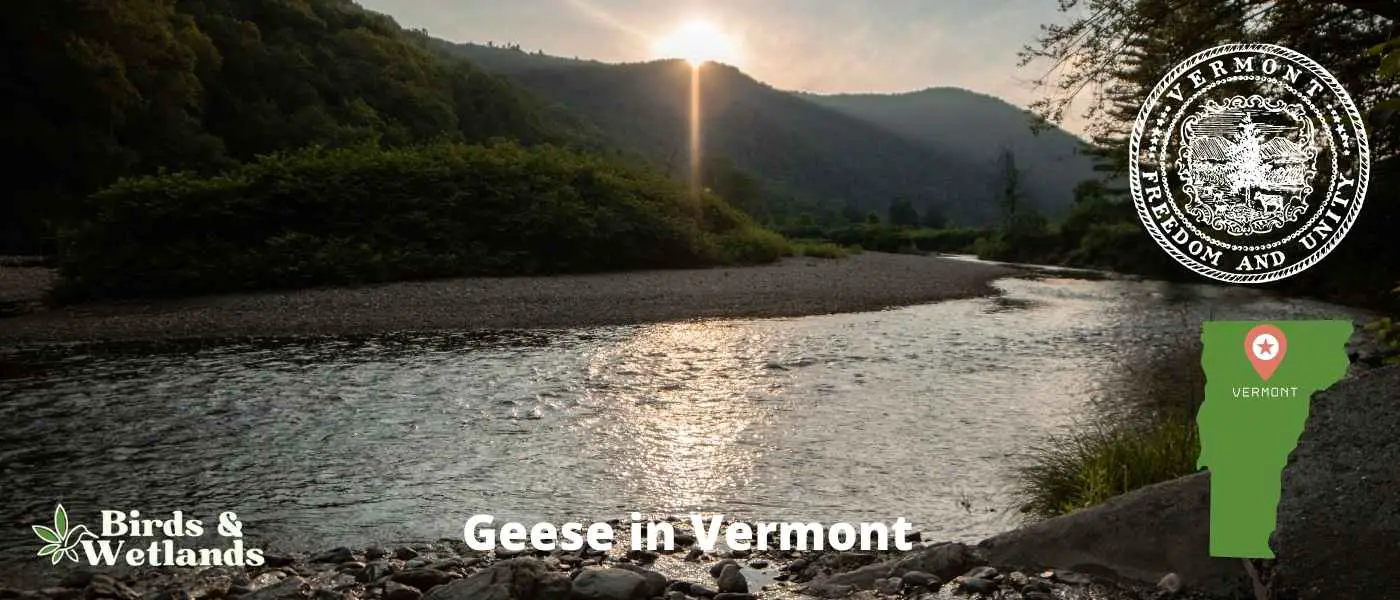Vermont has no less than eight different species of geese calling our state home!
Geese can be found in all corners of Vermont, but some areas are better for bird-watching than others like Dead Creek Wildlife Management Area or The Champlain Valley, but find out more below!
What Geese Are in Vermont?
Vermont is home to the following goose species:
- Canada Goose
- Snow Goose
- Ross’s Goose
- Cackling Goose
- Greater White-Fronted Goose
- Barnacle Goose
- Pink-footed Goose
- Brant
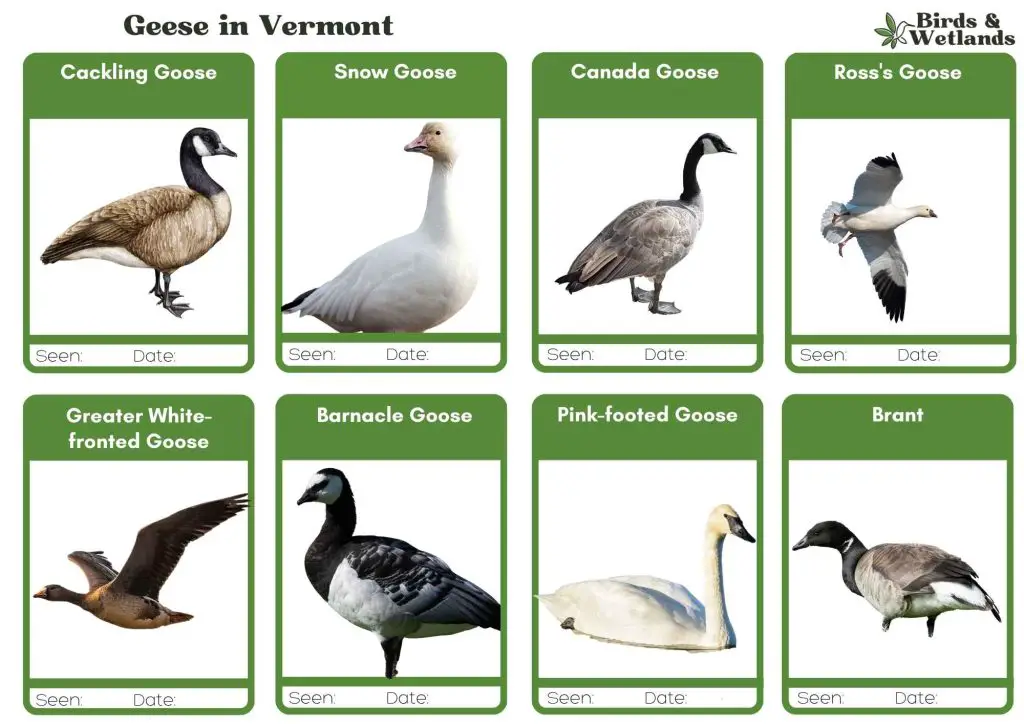
Canada Goose
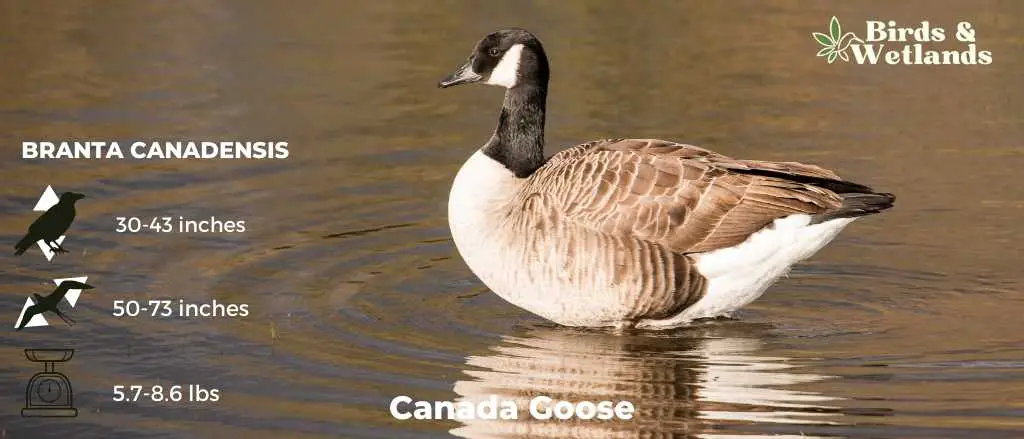
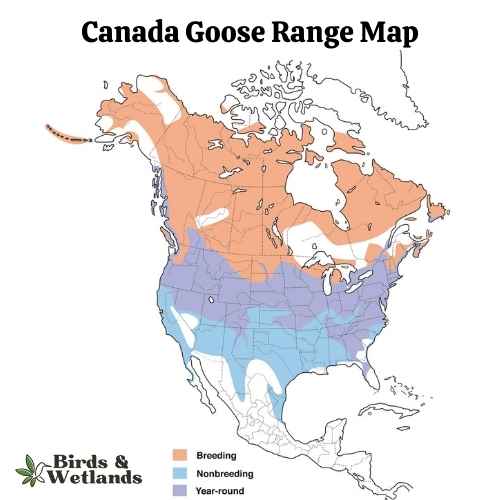
Canada Goose Sound
Scientific Name: Branta canadensis
Length: 30 to 43 in
Wingspan: 50–73 in
Weight: 5.7–14.3 lb
The Canada Goose is a large, well-known species of waterfowl noted for its distinctive appearance, familiar “honk,” and migratory behavior.
Appearance: Both male and female Canada Geese have a similar appearance, featuring a black head and neck with distinctive white patches on the cheeks and chin. The body is primarily brown with a lighter, often white, underbelly.
Diet: Canada Geese primarily feed on plant matter, including grasses, aquatic vegetation, and grains. They can often be seen grazing in parks, lawns, and fields, as well as dabbling in water bodies.
Reproduction: Canada Geese typically nest on the ground near water bodies, often on islands or other isolated areas to avoid predators. The female lays a clutch of about 4 to 6 eggs, which she incubates alone for around a month.
Snow Goose
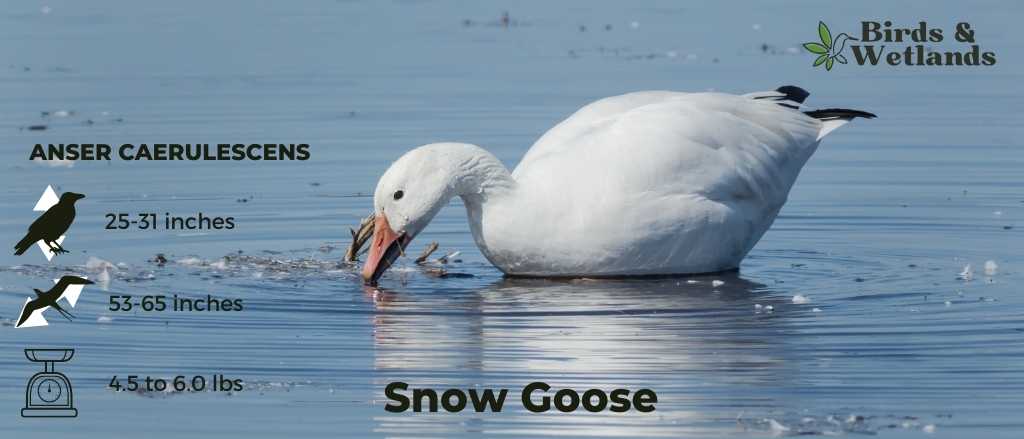
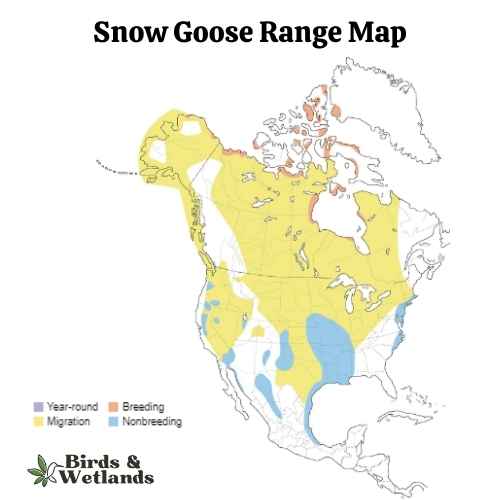
Snow Goose Sound
Scientific Name: Anser caerulescens
Length: 25 to 31 in
Wingspan: 53 to 65 in
Weight: 4.5 to 6.0
The Snow Goose is a large species of waterfowl known for its vibrant white plumage and significant migratory flights.
Appearance: True to their name, Snow Geese are predominantly white with black wingtips. They also have a pink bill, pink legs and feet. A color morph, known as the “Blue Goose,” displays a bluish-gray body with a white head, but is considered the same species.
Diet: Snow Geese primarily feed on plant matter, such as grasses, sedges, and small grains. They can often be seen in large flocks foraging in fields and marshes, and during migration and winter, they can cause considerable damage to agricultural fields due to their feeding habits.
Reproduction: Snow Geese typically nest on the tundra, near water bodies. The female builds the nest and lays a clutch of about 3 to 5 eggs, which she incubates alone for approximately three weeks. Once hatched, the goslings can feed themselves but stay with their parents for protection until they can fly.
Ross’s Goose
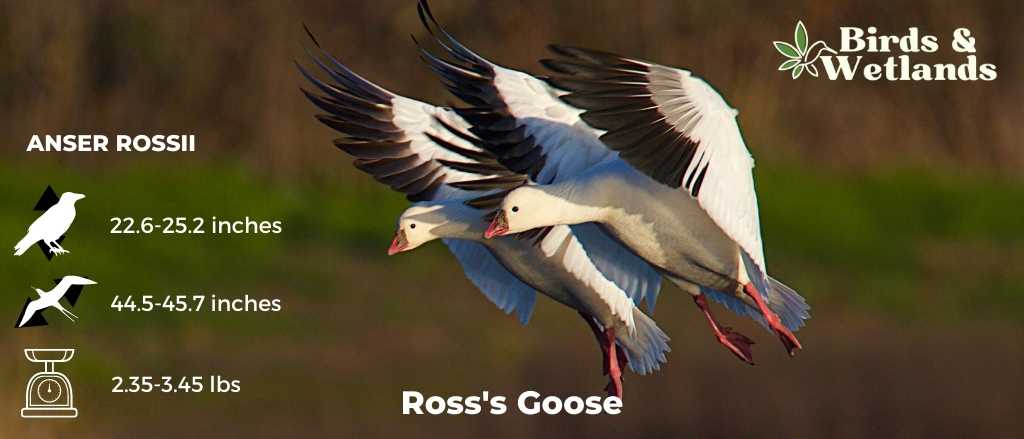
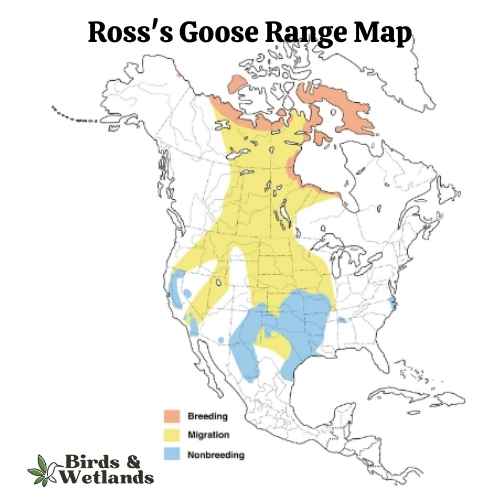
Listen
Scientific Name: Anser rossii
Length: 23.2-25.2
Wingspan: 44.5-45.7 in
Weight:42.3-55.3 oz
The Ross’s Goose is a small species of waterfowl often found in North America’s tundra and wetland habitats.
Appearance: Known for its compact size, the Ross’s Goose is mostly white with black wingtips. It features a short, stubby bill and a rounded head. One key identifying feature is the blueish gray base of its bill, which has a warty structure during the breeding season.
Diet: This goose feeds mainly on vegetation, including seeds, leaves, and roots of grasses and sedges. During winter and migration, they also consume grains and seeds from agricultural fields.
Reproduction: The Ross’s Goose nests on the ground, often in colonies. The female lays a clutch of 2 to 5 eggs which she incubates for around three weeks. The young geese, known as goslings, are precocial – they can walk, swim, and feed themselves shortly after hatching, although they stay with their parents until they learn to fly.
Cackling Goose
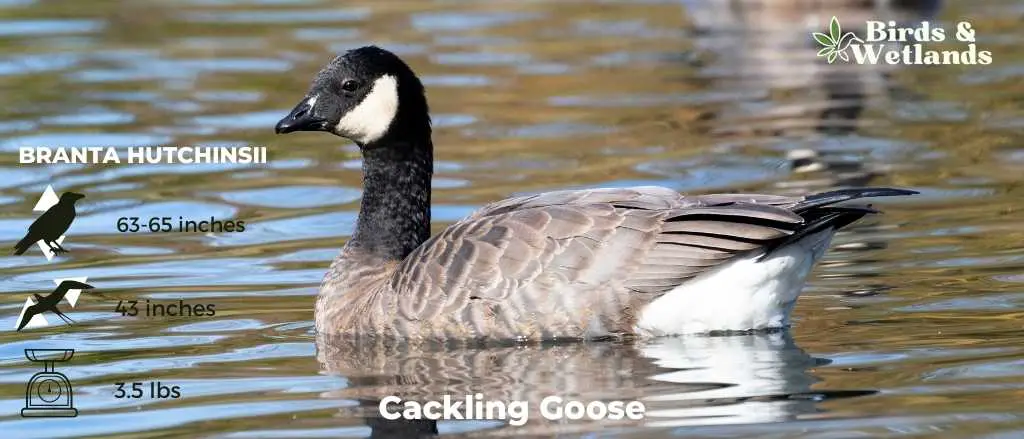
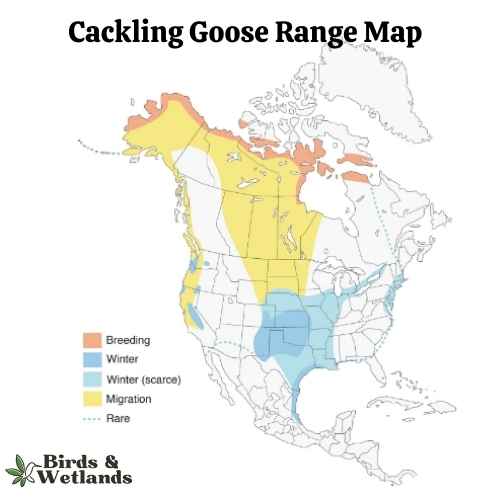
Listen
Scientific Name: Branta hutchinsii
Length: 24.8–25.6 in
Wingspan: 43-45.7 in
Weight:3.5 lbs
Cackling Geese are particularly known for their high-pitched, cackling calls, which is the source of their name. Despite their small size, these geese are renowned long-distance migrants, with some populations traveling thousands of miles between breeding and wintering grounds.
Appearance: With a similar color pattern to the larger Canada Goose, the Cackling Goose features a black head and neck, white chinstrap, light tan to cream chest, and brownish-grey body. One defining characteristic is its noticeably smaller size and stubbier neck compared to its larger counterparts.
Diet: Like many geese, the Cackling Goose’s diet mainly consists of plant matter. This includes grasses, seeds, and aquatic vegetation. They are often seen grazing on land or dabbling in shallow water.
Reproduction: Cackling Geese usually nest on the ground in elevated areas near water bodies, such as riverbanks or lakeshores. The female lays a clutch of 2 to 8 eggs and is responsible for incubation, while the male stands guard nearby. Incubation lasts for about a month.
Greater White-fronted Goose
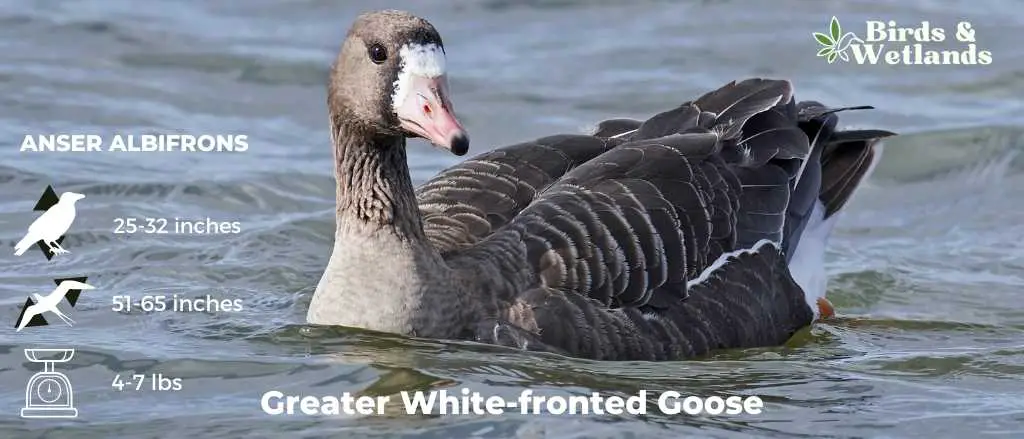
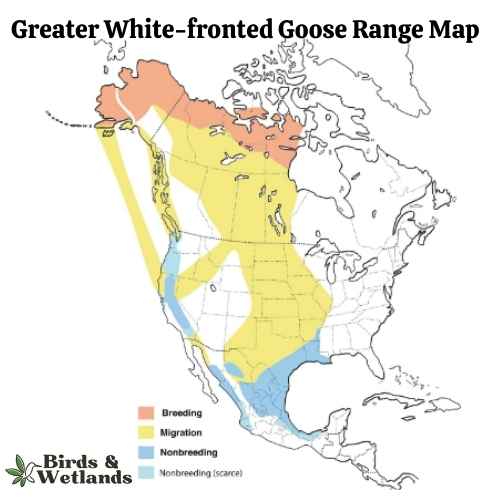
Listen
Scientific Name: Anser albifrons
Length: 25 to 31 in
Wingspan: 53 to 66 in
Weight: 3.3 to 6.6
The Greater White-fronted Goose is a medium to large waterfowl species, widely distributed across the Northern Hemisphere, particularly in North America.
Appearance: As the name suggests, these geese display a prominent white patch at the base of their bill. Their bodies are gray-brown, and their breasts are often marked with dark blotches. They possess a pinkish bill and orange legs and feet.
Diet: The Greater White-fronted Goose is a herbivore and feeds mainly on plant material. Its diet consists of grasses, sedges, grains, and berries. When wintering, these geese can often be found in agricultural fields, feasting on leftover grains and crops.
Reproduction: This species nests on the ground, often in areas with good visibility such as slopes or ridges. The female lays a clutch of 4 to 5 eggs, which she incubates for nearly a month. Once hatched, the young ones are taken care of by both parents until they are able to fly.
Barnacle Goose (Branta leucopsis)
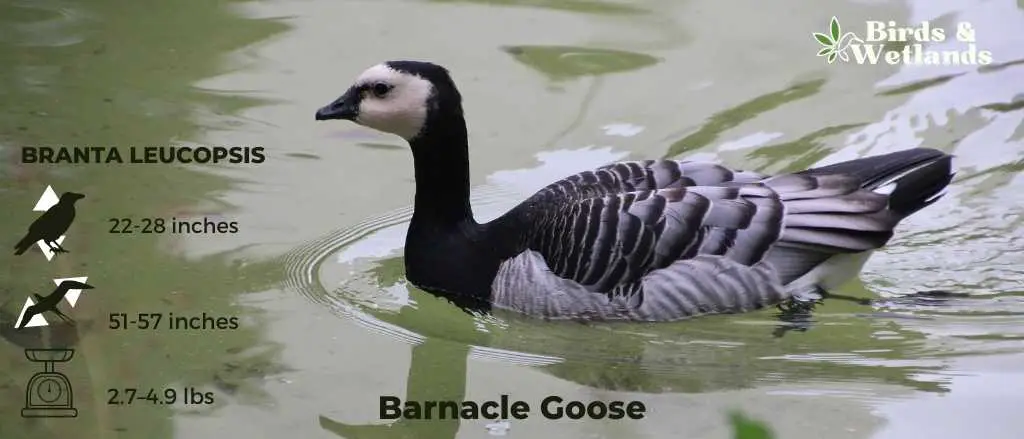
Rare in North America and when spotted its usually within a flock of Canada Geese.
- Scientific Name: Branta leucopsis
- Height: 55–70 cm (22–28 in)
- Wingspan: 130–145 cm (51–57 in)
- Weight: 1.21–2.23 kg (2.7–4.9 lb)
Barnacle Goose Description
The barnacle goose is a small goose with a white body and black wings, a black neck, with a white face and black bill. Its crown, eye line and legs are black.
Listen to Barnacle Goose
Barnacle Goose Habitat & Range
Barnacle geese are migratory geese that are native to the Arctic and northern Europe. They spend winters in southern Europe, Africa, India, and Australia. They breed in Iceland, Greenland, Northern Scandinavia, and Canada.
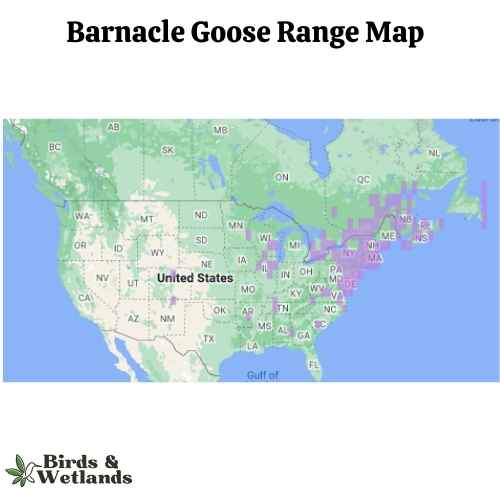
Barnacle Goose Diet
Barnacle Geese feed primarily on grasses, leaves, and other aquatic plants, grains, and algae during their breeding season but also consume insects during migration periods when food may be scarce.
Barnacle Goose Nesting
The Barnacle Goose lays 4-6 eggs in a nest lined with down but on the rock edge. The young Barnacle Goslings have to undergo significant challenges making their way from cliff edges to the water below a few hours after hatching.
Pink-footed Goose (Anser brachyrhynchus)
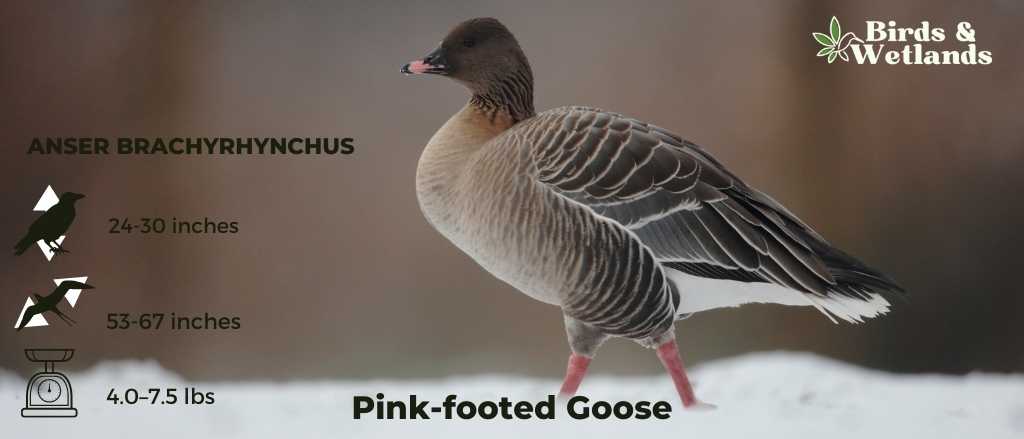
- Scientific Name: Anser brachyrhynchus
- Height: 60–75 cm (24–30 in)
- Wingspan: 135–170 cm (53–67 in)
- Weight: 1.8–3.4 kg (4.0–7.5 lb)
This is a rare visitor to North Eastern US, but becoming increasingly more common as it migrates with other geese species. It is a small goose which breeds in the Artic.
Pink-footed Goose Description
The Pink-footed Goose is a medium-sized goose with a pinkish bill and legs, as well as a white belly. It has a white head and neck with a black stripe running down its back and a black tail. The body is white except for a black breast, belly, and vent. The bill is yellow and red, with yellow on top and red on the bottom. The legs are pink.
Listen to Pink-footed Goose
Pink-footed Goose Habitat & Range
It’s a migratory goose that breeds in Iceland, Greenland, and Scandinavia. It winters on the coasts of North America and Europe. They are also known for gathering in large flocks to feed or roost together during migration.
In winter, they migrate south to warmer climates in Europe or Africa. The population is large enough that they can survive in areas where there is no natural water source for them to nest in—they simply dig holes in dry grassland instead.
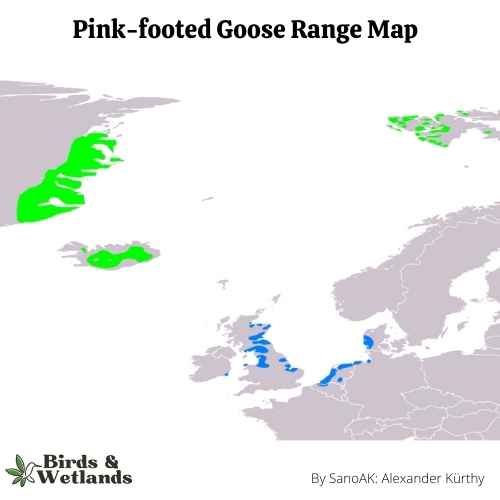
Pink-footed Goose Diet
Pink-footed geese feed on aquatic plants, including algae and tubers such as sedges and grasses; they also eat small fish and invertebrates such as snails or worms when they can find them.
Pink-footed Goose Nesting
They breed on the Arctic tundra near ponds or lakes that have open water in summer. Their nests are made formed in rocky crags. They lay 3-6 eggs per clutch and both parents incubate them for about 25 days.
Brant
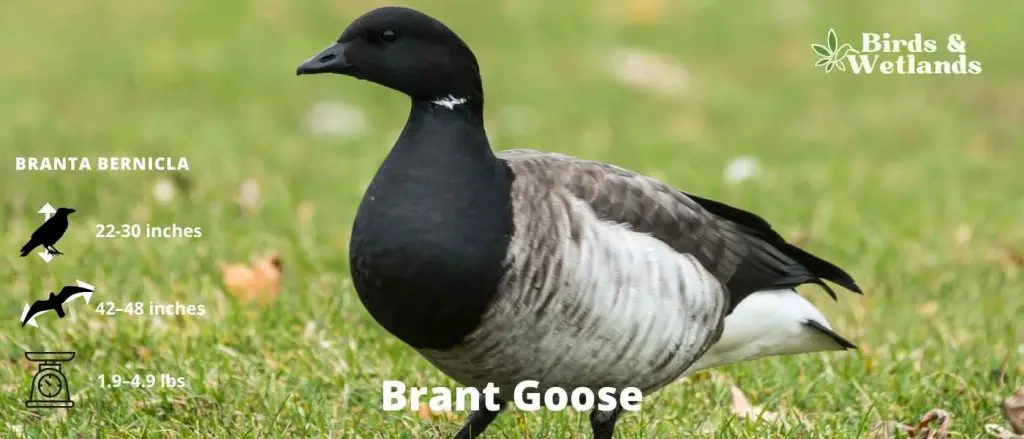
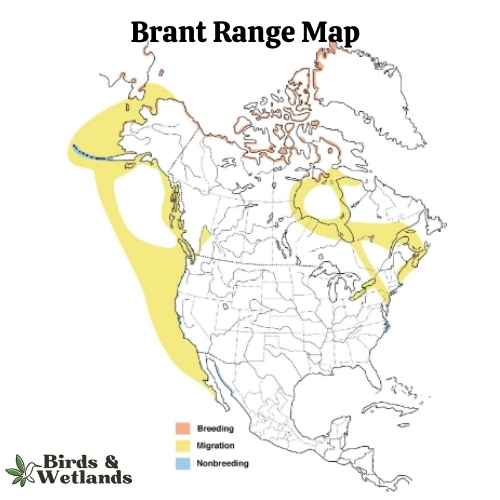
Listen
Scientific Name: Branta bernicla
Length: 22–26 in
Wingspan: 42–48 in
Weight: 1.9–4.9 lb
The Brant is a compact species of goose that is known for its striking appearance and interesting migratory patterns.
Appearance: The Brant is recognized for its dark, sooty color with a white crescent on the neck. The body is mostly black to dark gray, contrasting with the lighter underparts. Its small size, as compared to other geese, and short, stubby bill are other distinct features.
Diet: The Brant’s diet primarily consists of aquatic plants, especially eelgrass and sea lettuce. During the breeding season, they may also feed on grasses, sedges, and insects.
Reproduction: Brants typically breed in the high Arctic tundra. The female lays a clutch of 3 to 5 eggs in a ground nest, which she incubates for about a month.
Notably, Brants make an impressive long-distance migration every year. They spend their winters along both the east and west coasts of the United States and travel to the Arctic regions of Canada, Alaska, and even Russia to breed.
Where to Watch Geese in the State of Vermont?
Vermont is a popular destination for geese during the spring migration. Each year, thousands of geese make the journey to through Vermont since it is along the Atlantic Flyway, as a stopover for these migrating birds.
Dead Creek Wildlife Management Area is one of the best places to see them.
The Champlain Valley is also a good spot to view geese, particularly in late March and early April. During this time of year, many different species of geese can be seen in Vermont.
Are There Any Resident Geese Flocks In Vermont?
Resident Canada geese are found throughout Vermont in agricultural fields, pasturelands, hayfields, golf courses, parks, and along rivers and ponds.
In the agricultural fields, they feed on leftover grain and grasses. On golf courses, they eat the grass that is trimmed around the greens and fairways.
In parks, they eat the grass that is found in open fields and along trails. And along rivers and ponds, they eat aquatic plants, small fish, and invertebrates.
Although they are typically found in these areas, they will also occasionally venture into urban areas to forage for food.
Some consider that these resident geese have become a nuisance, destroying habitat and some of them are aggressive.
Geese Hunting in Vermont
Hunting is a popular pastime in Vermont, and there are many different animals that can be hunted in the state with one of the most popular animals to hunt is geese.
While hunting geese can be a fun and challenging experience, it is important to make sure that you are following all of the state’s regulations.
In Vermont, you need a license to hunt geese, as well as a federal duck stamp.
You can purchase the appropriate licenses, permits and stamps from Vermont Fish and Wildlife Department.
Can You Shoot a Goose in Vermont?
In Vermont, you can shoot geese with a shotgun that has a one-piece plug or is manufactured to restrict it to a three-shot capacity.
Only non-toxic shots approved by the U.S. Fish and Wildlife Service are allowed.
Waterfowl may be taken only by shotgun, so you’ll need to make sure your gun meets the requirements before heading out.
Additionally, you should be aware of the daily bag limit and possession limit set by Vermont Fish and Wildlife Department so that you will know how many birds you can have.
The office allowed the reduction of the population of migrating greater and lesser snow geese.
Where Can I Hunt Geese in VT?
Geese are a popular game bird in Vermont, and there are three main areas where they can be hunted: the Lake Champlain Zone, the Connecticut River Zone, and the Interior Vermont Zone.
Each zone has its own rules and regulations, so be sure to check with the Vermont Fish & Wildlife Department before heading out.
The Lake Champlain Zone, which includes Lake Champlain and the adjoining Champlain Valley lowlands, is the most popular area for goose hunting, as it offers a variety of habitats and a large population of birds.
The Connecticut River Zone is also a good place to hunt, though it can be more challenging due to the narrower terrain.
The Interior Vermont Zone is typically less crowded than the other two zones, making it a good choice for those looking for a more peaceful hunting experience.
There are controlled hunts in Mud Creek and Dead Creek WMAs.
Regardless of where you go, you’re sure to enjoy some great goose hunting in Vermont.
Is There a Goose Hunting Season in Vermont?
Yes. Goose hunting season in Vermont takes place in the months of September to January. A conservation order usually happens from March to April.
Conclusion on Geese in VT
If you’re looking for a great place to bird-watch or hunt waterfowl, Vermont is the perfect state. With eight different species of geese and plenty of other birds, you’re sure to see something interesting.
Be sure to check out some of the great locations we’ve highlighted in this post!

